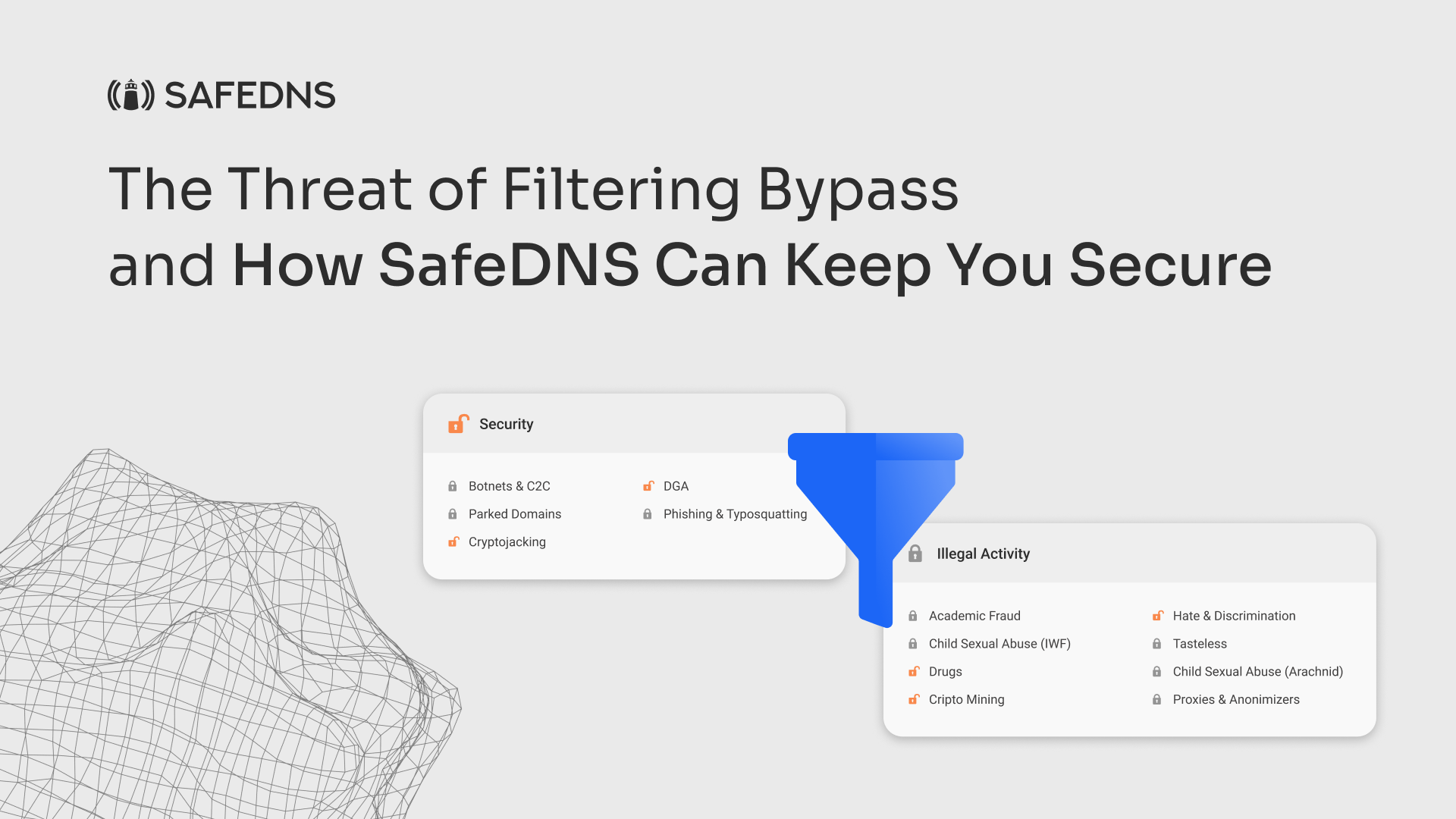
The Threat of Filtering Bypass and How SafeDNS Can Keep You Secure
Picture this: you've successfully set up your content filter, creating a reassuring shield for your digital realm. Confidence grows as you believe your online world is now safeguarded against unwanted content and potential threats. But here's the reality check: the digital landscape is a crafty one, and determined individuals can find their way around and easily bypass your barriers. In this situation knowledge is your power. Let's delve into the realm of filter bypass, uncovering its intricacies and equipping you with insights to fend off potential breaches.
The Danger of Bypassing Filtering
Content filtering plays a crucial role in maintaining a safe and secure online environment. By preventing access to malicious websites, adult content, and other harmful resources, content filtering tools like SafeDNS shield users from potential harm. Bypassing these various web filters, intentionally or unintentionally, can lead to a range of risks, including:
Exposure to Inappropriate Content: Bypassing filters may result in users accessing explicit, violent, or inappropriate content, putting individuals, especially children, at risk.
Malware and Phishing Attacks: Unfiltered access to internet also increases the likelihood of encountering malicious websites that can distribute malware, launch phishing attacks, and have other methods to compromise sensitive data.
Productivity Loss: Employees bypassing filters might spend work hours on social media sites and non-work-related websites, leading to decreased productivity and potential security vulnerabilities.
Legal and Compliance Issues: Bypassing filters could lead to legal issues if users access copyrighted materials, engage in cyberbullying, or involve themselves in other illicit activities.
How Bypassing Filtering Works and the Role of VPNs
Bypassing content filtering often involves the use of proxies, anonymizers, and Virtual Private Networks (VPNs). These tools mask users' true identities and locations, allowing them to quickly access restricted content. VPNs, in particular, create a secure and encrypted tunnel between the user's computer or device and a remote server, effectively cloaking online activities from prying eyes.
VPN providers and VPN connections can help bypass filtering and access a blocked website by:
- Masking IP Addresses: VPNs hide users' IP addresses, making it difficult for content filtering systems to accurately identify and block restricted content.
- Encryption: Encrypted connections provided by VPNs prevent network administrators from inspecting the content of data packets, further complicating filtering efforts.
- Geo-Spoofing: VPNs can make it appear as though a user is browsing from a different location, potentially bypassing regional content restrictions.
Accessing Blocked Websites with DNS Servers and Proxy Servers
In addition to VPNs, users may also employ DNS servers and proxy servers to access blocked websites. DNS servers and free proxies, such as Google Public DNS, can be configured to resolve domain names for blocked websites, effectively circumventing content filters. A proxy server and proxy websites act as intermediaries between users and blocked content, making it appear as though the requests are originating from an unrestricted source.
Preventing Bypass with SafeDNS
SafeDNS has taken proactive measures to address bypass concerns. Our intuitive solution empowers you to prevent bypass attempts with ease.

In the SafeDNS dashboard, under the "Illegal Activity" section, you have the option to block the "Proxies & Anonymizers" category. By doing so, you proactively thwart attempts to bypass content filtering through these means. This simple yet powerful step enhances your defense against content filtering evasion, ensuring that the browsing traffic on your network remains secure and productive.
When you choose to block the VPN and anonymizer category, you essentially curtail access to all categorized resources that could potentially serve as conduits for traffic circumvention services. In practical terms, this means that users are prevented from downloading such software and initiating any attempts to bypass traffic filtering.
Even in scenarios where such bypass-enabling software has already been downloaded, SafeDNS still offers protection, albeit with certain limitations. If the software communicates with its servers through domains, for example, we can effectively shield your network from bypass attempts. However, if the software relies on IP addresses for communication, our protective measures may not be as effective in this specific scenario.
In conclusion, understanding the dangers of bypassing content filtering is crucial for maintaining a safe online environment. Use of protective measures of SafeDNS, such as bypass prevention and blocking category proxies and anonymizers, significantly strengthens your network's security posture. By staying vigilant and taking proactive steps, you can ensure that your network remains a safe and productive space for all users.
Take advantage of the SafeDNS trial period and try all the best features

